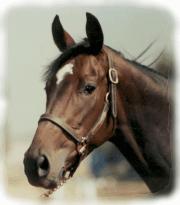A Horse, of Course with Don Blazer |
If you enjoy learning about horses, then you'll love our online courses. Each month you'll find a new column on our web site. We hope you'll enjoy it, and maybe e-mail us with questions or suggestions for other columns. A Horse, Of Course is a monthly column syndicated by Success Is Easy. If you like the column, call your local newspaper, or local horse publication and ask them to subscribe by contacting Success Is Easy. |
Use Instincts When Training Horses Don Blazer copyright©2011 |

Great horse training is more a matter
of thinking than anything else! Great trainers understand how a horse thinks and why he thinks that way-which is a matter of "instinct." Mentally a horse is consistent and reasonable because he is reacting consistently and reasonably. (It is the human which is inconsistent and unreasonable.) All of the horse's mental processes (in order of importance) are founded in the 7 instincts: the herd instinct, need for security, the following instinct, love of routine, laziness, excitability and nervousness, sensitivity and courage. Even though most horses don't live in a herd today, it is still the "companionship" instinct which is strongest. Young horses and unschooled horses are reluctant to leave a group, but when training begins they are frequently forced to do just that. The thinking trainer uses the herd instinct to smooth the early training process. For example, young horses are accompanied by an older, trained horse when they are asked to leave their "home" area (stable or pasture). Training areas, by design, are close enough to "home" to be familiar, yet far enough away from a group of horses so as not to be distracting. Young horses should be allowed to watch companions perform a maneuver before being asked to do the same…such as walking across water, or jumping. Youngsters should be schooled moving toward their friends rather than away. As the horse learns to respect and trust the handler (this doesn't mean being spoiled or coddled) the horse will become more secure (2nd instinct-need for security) and therefore more calm-a prerequisite to learning. The following instinct, which can be translated as "obey", makes the horse surprisingly cooperative. But it can be a double edged sword. If the handler knows what she is asking, and is consistent, the horse will perform maneuvers as intended. However, if the trainer is inconsistent, or is not sure about how a maneuver should be performed, the horse will act as he perceives the request, but running away, throwing his head, stopping at jumps, etc. The love of routine is basic to the horse's security, calm and well-being, just as it is basic to training methods. Thinking trainers map out a program of progress for the horse, repeating basic steps and building upon them. The love of routine is linked to the horse's natural "laziness." Understanding the horse is lazy by nature, only a foolish trainer will ask for more than is required. If a horse gets a maneuver correct and demonstrates he understands the rider's request, the horse should be praised and given a "break". It is bad training to ask a horse to do an exercise over and over again…that's not good use of love of routine. Use the love of routine, in combination with laziness, the next day by requesting a well understood maneuver, then giving a lot of praise and a rest. Everyone, including the horse, likes to do what she can do well and everyone likes to be praised for accomplishments. Horses are excitable and nervous, traits that in years past helped them avoid predators. The horse's nervous system is highly tuned. Shouting at or abusing a frightened horse only makes matters worse. Linked to excitability and nervousness is the great sensitivity of the horse, without which it would be impossible to achieve subtle cues. Knowing the horse's sensitivity, the thinking trainer always begins with a minimal cue, never with a more forceful one. A horse's courage is demonstrated in the fact that horses keep trying to get along with their handlers. The most useful attribute of the horse's mind is his extraordinary memory. Put in the correct things and you get back the correct response. Put in anything else and that is what you get back. For the horse's memory to work well, however, cause and effect, reward and punishment must be closely related in time. Don't wait to praise the horse for correct action, or reprimand for disobedience. Take praise or discipline action immediately. (Discipline is only used when the horse knows the correct response, but refuses. Discipline is not used in any situation where the horse is just learning a response.) Horses have "horse sense" (instincts); thinking trainers make horse sense their own. |